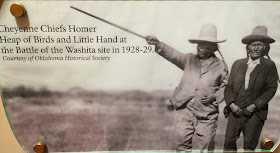From Wiki: Washita Battlefield National Historic Site protects and interprets the site of the Southern Cheyenne village of Chief Black Kettle where the Battle of Washita occurred. Just before dawn on November 27, 1868, the village was attacked by the 7th U.S. Cavalry under Lt. Col. George Custer.
The strike was hailed at the time by the military and many civilians as a significant victory aimed at reducing Indian raids on frontier settlements as it forced the Cheyenne back to the reservation set aside for them. However, Washita remains controversial because many Indians and whites labeled Custer's attack a massacre. Black Kettle is still honored as a prominent leader who never ceased striving for peace even though it cost him his life. The site was declared a National Historic Landmark in 1965, and was listed on the National Register of historic places in 1966
In my opinion, and I qualify it with fact that I wasn't there and, I didn't live in those time, but, in retrospect, we did some terrible things to our Native Americans. I realize there were enough atrocities to go around from both sides, but oh my, how sad it makes me feel. And for the poor soldiers as well, who were just taking orders. But many went way beyond written or spoken orders.
These pics are from within the museum or from the actual site of the battlefield. The battlefield is located about a mile west along the south side of the Washita River bank, approximately 2 miles northeast of Cheyenne, OK.
On the fence in the background, note the many cloth memorials tied around the upper rungs. They represent descendants' tie to their long lost family members who lost their lives on that fateful day. I wasn't really are of photographing them until after I went over and read the signage (above). My apologies to the families, but no mal-intent is intended here.
Above, the May 15 afternoon sun shines on the visitor center. Behind me down the road lies the battlefield memorial.
We parked the motor home in town at a little town park. It was a dry camping night, but the weather was pleasant. There many activities going in the park. Playgrounds, ball fields, grassy areas for games and girls softball hitting practice.
There was even a small reconstructed village in the park dedicated to the early days of the town.
This is a short blog, but that's OK because some of my blogs are too long. So it's refreshing to do one in 10 minutes. This blog is way late, as I write it from Tacoma, WA June 22, 2015, right after the US Open. Till our next blog, Joe and Nancy, the RVing Beach Bums signing off.















































































